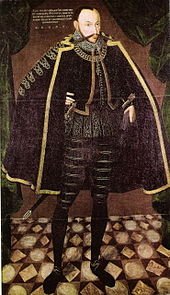
In the duchies of Schleswig and Holstein, the term "partitioned-off duke" (German: Abgeteilte Herren) was used to denote a series of dukes whose territories were not recognized by the estates of the realm.

In the duchies of Schleswig and Holstein, the term "partitioned-off duke" (German: Abgeteilte Herren) was used to denote a series of dukes whose territories were not recognized by the estates of the realm.
The background for this phenomenon was the Treaty of Ribe of 1460, in which King Christian I of Denmark, after his election as Duke of Schleswig and Count of Holstein, had laid down that Schleswig and Holstein should forever be ruled by a joint sovereign, in a personal union with Denmark. The promise was broken in 1544, when King Christian III of Denmark divided the territories between himself and his half-brothers John II the Elder and Adolf. However, when Christian's son, Frederick II of Denmark, tried to divide the territory with his brother, John II the Younger, the Estates refused to pay John II homage. John II was given the title and rank of a duke, as well as the income from his own lands, but de facto rule over Schleswig and Holstein remained with his brother and uncle. John thus founded the Schleswig-Holstein-Sonderburg branch of the House of Oldenburg.
His partitioned-off duchy was not allowed to mint coins, nor to maintain a standing army. After his death, it was further subdivided among his children, creating several collateral branches of the House of Schleswig-Holstein-Sonderburg.

Christian IX was King of Denmark from 15 November 1863 until his death in 1906. From 1863 to 1864, he was concurrently Duke of Schleswig, Holstein and Lauenburg.
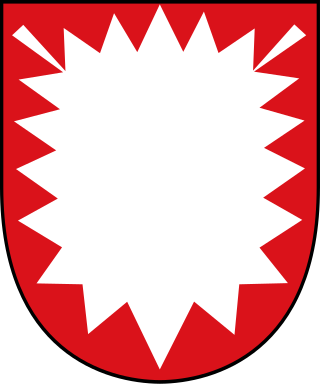
Holstein is the region between the rivers Elbe and Eider. It is the southern half of Schleswig-Holstein, the northernmost state of Germany.

The history of Schleswig-Holstein consists of the corpus of facts since the pre-history times until the modern establishing of the Schleswig-Holstein state.
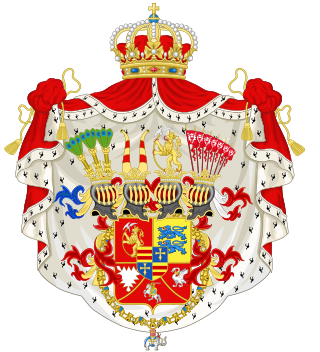
The House of Glücksburg is a collateral branch of the German House of Oldenburg. Its members have reigned at various times in Denmark, Norway, Sweden, Iceland, Greece, and several northern German states.
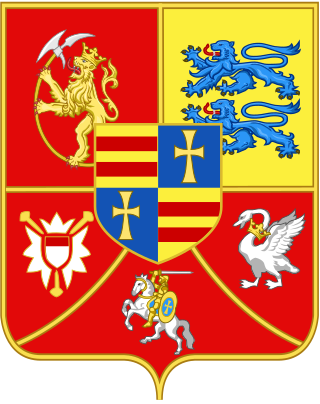
Holstein-Gottorp or Schleswig-Holstein-Gottorp is the historiographical name, as well as contemporary shorthand name, for the parts of the duchies of Schleswig and Holstein, also known as Ducal Holstein, that were ruled by the dukes of Schleswig-Holstein-Gottorp, a side branch of the elder Danish line of the House of Oldenburg. Other parts of the duchies were ruled by the kings of Denmark.
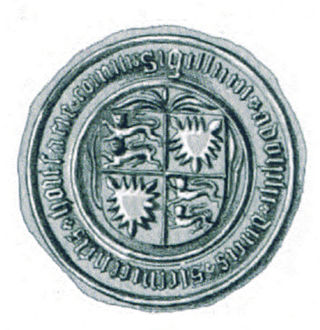
Adolphus XI of Schauenburg, as Adolph I Duke of Schleswig, and as Adolph VIII Count of Holstein-Rendsburg, was the mightiest vassal of the Danish realm.
The Treaty of Ribe was a proclamation at Ribe made in 1460 by King Christian I of Denmark to a number of Holsatian nobles enabling himself to become Count of Holstein and gain control of the Duchy of Schleswig. The most famous line of the proclamation was that the Danish Duchy of Schleswig and the County of Holstein within the Holy Roman Empire, should now be, in the original Middle Low German language, Up Ewig Ungedeelt, or "Forever Undivided".

The Duchy of Saxe-Lauenburg, was a reichsfrei duchy that existed from 1296 to 1803 and again from 1814 to 1876 in the extreme southeast region of what is now Schleswig-Holstein. Its territorial center was in the modern district of Herzogtum Lauenburg and originally its eponymous capital was Lauenburg upon Elbe, though in 1619 the capital moved to Ratzeburg.

Adolf of Denmark or Adolf of Holstein-Gottorp was the first Duke of Holstein-Gottorp from the line of Holstein-Gottorp of the House of Oldenburg.
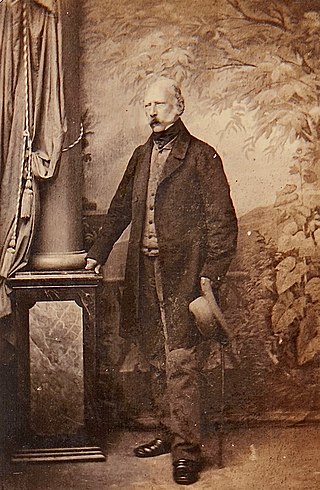
Christian August II, Duke of Schleswig-Holstein-Sonderburg-Augustenburg, commonly known as Christian, Duke of Augustenborg, was a Danish/German prince and statesman. During the 1850s and 1860s, he was a claimant to first duke of the whole provinces of Schleswig and Holstein, and a candidate to become king of Denmark following the death of King Frederick VII. He was the father-in-law of Princess Helena and the paternal grandfather of Augusta Victoria, German Empress and wife of Kaiser Wilhelm II.

Frederick Christian II, Duke of Schleswig-Holstein-Sonderburg-Augustenburg was a Danish prince and feudal magnate. He held the island of Als and some other castles in Schleswig.

The Duchy of Holstein was the northernmost state of the Holy Roman Empire, located in the present German state of Schleswig-Holstein. It originated when King Christian I of Denmark had his County of Holstein-Rendsburg elevated to a duchy by Emperor Frederick III in 1474. Members of the Danish House of Oldenburg ruled Holstein – jointly with the Duchy of Schleswig – for its entire existence.
Holstein-Glückstadt or Schleswig-Holstein-Glückstadt is the historiographical name, as well as contemporary shorthand name, for the parts of the duchies of Schleswig and Holstein that were ruled by the Kings of Denmark in their function as dukes of Schleswig and Holstein, thus also known as Royal Schleswig-Holstein. Other parts of the duchies were ruled by the Dukes of Schleswig-Holstein-Gottorp. The territories of Holstein-Glückstadt are located in present-day Denmark and Germany. The main centre of administration was Segeberg and from 1648 Glückstadt on the River Elbe.

Schleswig-Holstein-Sonderburg was the name of a branch line of the House of Oldenburg as well as the name of their land. It existed from 1564 until 1668 and was a titular duchy under the King of Denmark, rather than a true territorial dukedom in its own right. The seat of the duke was Sønderborg. Parts of the domain were located in Denmark, mainly on the islands of Als and Ærø and around Glücksburg, whilst other lands were part of the Holy Roman Empire, including the Ämter of Plön, Ahrensbök, and Reinfeld. As a result of various inheritance arrangements it fragmented into numerous small territories which were eventually absorbed into Greater Denmark in the 18th century.

Frederick Charles of Schleswig-Holstein-Sonderburg-Plön, known as Friedrich Karl or Friedrik Carl of Holstein-Plön, was a member of a cadet branch of the Danish royal family and the last duke of the Duchy of Schleswig-Holstein-Sonderburg-Plön, a Danish royal prince, and a knight of the Order of the Elephant. When he died without a male heir born of his marriage to Countess Christine Armgard von Reventlow, rule of the Duchy of Holstein-Plön returned to the Danish crown.

The Duchy of Schleswig-Holstein-Sonderburg-Plön, also Schleswig-Holstein-Plön, Holstein-Plön or just Duchy of Plön, was a small sub-duchy (Teilherzogtum) created by the physical division of the Duchy of Schleswig-Holstein-Sonderburg. Today, its remaining significance is primarily the building of Plön Castle. The Duchy of Plön was not a territorial dukedom in its own right, but a sub-division within the state structure of the duchies of Schleswig and Holstein. The scattered territorial dominion lay mostly in the southeast part of present-day German state of Schleswig-Holstein.

The sub-duchy of Schleswig-Holstein-Sonderburg-Norburg emerged as a collateral line of the House Schleswig-Holstein-Sonderburg. The region of Nordborg is on the island of Als.
Dorothea Augusta of Schleswig-Holstein-Gottorp was a German noblewoman from the House of (Schleswig-)Holstein-Gottorp, a cadet branch of the House of Oldenburg. She became the first Duchess of Schleswig-Holstein-Sonderburg-Plön as the wife of Duke Joachim Ernest (1595–1671).
The Treaty of Tsarskoye Selo was a territorial and dynastic treaty between the Russian Empire and Denmark–Norway. Signed on 1 June 1773, it transferred control of ducal Schleswig-Holstein to the Danish crown in return for Russian control of the County of Oldenburg and adjacent lands within the Holy Roman Empire. The treaty reduced the fragmentation of Danish territory and led to an alliance between Denmark–Norway and Russia that lasted into the Napoleonic Wars. It also made possible the construction of the Eider Canal, parts of which were later incorporated into the Kiel Canal.